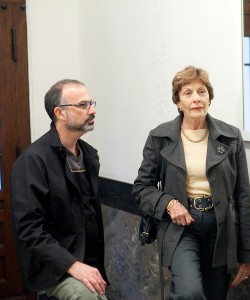Flat searches for personal, historic truths
It’s often said that you are what you eat. In Israeli filmmaker Arnon Goldfinger’s new documentary, though, you are what you own.
Identity plays a major role in The Flat, which follows Goldfinger’s effort to piece together parts of his family history, which is full of questions and contradictions about the Holocaust.

Holocaust history · Israeli filmmaker Arnon Goldfinger (left) and his mother visit relatives in Germany to shed light on their family’s past. – | Photo courtesy of David Baltzer
The film begins with Goldfinger clearing the remnants of his grandmother’s home in Tel Aviv, Israel. Though his 98-year-old grandmother Gerda never appears in the documentary (except in photographs), her character takes on a life of its own, as her possessions — ranging from old minks to a Shakespeare collection — are organized and stuffed into plastic garbage bags. These scenes capture the no-limits nature of sifting through the belongings of a loved one and are especially impacting for anyone who has ever been placed in such a position.
While shuffling through Gerda’s items, Goldfinger is somewhat startled at the discovery of a Nazi tabloid known for unfettered propaganda. Piecing together clues from tattered photographs and faded newspaper clippings, Goldfinger discovers a relationship between his grandparents, German-Jews who moved to Tel Aviv in the 1930s and a high-ranking official in Adolf Hitler’s Ministry of Propaganda.
What makes the film special is that it is about more than simply what Gerda and her family physically own in the Tel Aviv flat. It also shines a light on what they own in terms of family history and collective memories.
Goldfinger’s discovery spurs a curiosity to understand the truth about what drove the close relationship between his grandparents and the Nazi propagandist Leopold Itz von Mildenstein — a relationship that continued even after the war ended and the Nazi’s crimes had been brought to the fore.
Denial exists on both sides of the relationship, as Goldfinger learns when he informs his mother and Mildenstein’s daughter of his findings. Unlike characters from the older generation, Goldfinger approaches the war more analytically and with less emotion. Rather than working toward accepting an incomplete history, Goldfinger constantly acquires the facts to compose an accurate account of the past.
The film then asks questions and examines how the merits of truth have changed from one generation to the next. Goldfinger’s mother, for one, was trained not to cast doubts on her family’s history. Throughout the film, she asks her son Arnon what the point of his quest is and why it is necessary. And it’s a fair question: Why stir the pot when all has been calm?
The divide between Goldfinger’s generation and that of his mother is clearly explained when Goldfinger interviews one of Gerda’s close friends.
“Why do only third-generation Germans ask questions?” Gerda’s friend asks. “The second generation didn’t ask what happened. You don’t understand and I’m glad you don’t understand.”
Distanced from history, Goldfinger is able to ask the questions that his mother never could, and, in the end, the film argues that this is a good thing.
Though the compelling story of Goldfinger’s quest drives The Flat, the film brings a careful attention to detail, particularly in Goldfinger’s direction. Repeated cuts to the opening of window shades, for example, convey a contemplative tone even before Goldfinger’s narration reinforces it. Techniques such as this help guide the film, giving the story greater depth by allowing it to visually establish an emotional connection with the audience.
The Flat might also intrigue audiences because its composition differs from most documentaries concerning the Holocaust. To tell his story, Goldfinger, who wrote and directed the film, breaks away from the History Channel model and refrains from using repeated images of ghettos or concentration camps. Instead, he relies on uncovering the truth about the past through the clues at his disposal — oral interviews, historical documents and public records.
At times, The Flat can be a little difficult to follow. But Goldfinger’s steady narration tempers this issue to an extent by helping those watching determine what is important information and what is irrelevant.
For a historically specific film, The Flat is uniquely universal. It is, at its core, a statement about the human character and contains something for everyone who has ever been plagued by the inescapable desire to answer the question: Where am I from?
